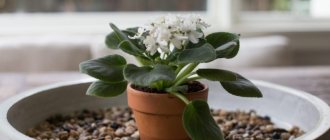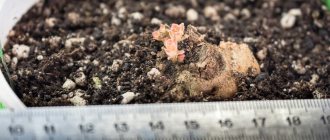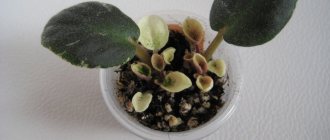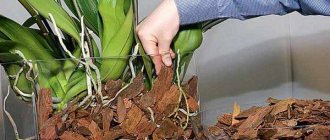Differences in winter care
Caring for Saintpaulias in winter in our not too mild climate is not easy because these flowers are very heat-loving plants, but do not tolerate direct sunlight, and our winters do not indulge in an abundance of warm, cloudy days. It often happens that violets in winter take on a sluggish and withered appearance, so it is advisable to give Saintpaulia a place on the windowsill with a view to the north or west, or to cover the flower with curtains. The health of the Saintpaulia variety Winter Cherry is well illustrated by its leaves.
If the violet leaves have a fresh green color and are located symmetrically, then everything is in order with the plant and you are caring for it correctly.
If part of the flower has turned yellow, you should turn its “sick” side towards the sun. To properly care for these flowers at home during the cold period, you need to ensure that the diameter of the container where they grow does not exceed fifteen centimeters. The soil in the pot with Saintpaulia should be loose without lumps. It is better to mix ordinary soil for caring for Winter Cherry flowers at home with expanded clay in equal proportions. In order for Saintpaulias to feel comfortable at home, the soil on which they grow should be constantly moistened, but make sure that the root system of the plant does not rot.
Caring for violets at home in winter
Hypothermia protection
A drop in temperature is very dangerous for Saintpaulia. If the pots with the plant are on the windowsills, you need to protect the violets from hypothermia.
In winter, violets on the windowsill may freeze.
A good option is a foam stand. It holds heat well and has low thermal conductivity. In winter, this is very useful, since the foam also prevents the violet from overheating from the flow of hot air from the radiators.
In cold weather, you need to make sure that the leaves of the plant do not touch the window glass . By coming into contact with condensation formed on the window, the plant runs the risk of rotting or becoming infected with fungus. You can thermally insulate glass with a special material or protective film.
It is recommended to use plastic pots for Saintpaulia , which have low thermal conductivity.
Maintaining a comfortable temperature
The preferred temperature for violets is 18-22 ºC . If the temperature drops below 16 ºC, the plant goes into a dormant state. The absorption of carbon dioxide is reduced, which leads to a decrease in the movement of water through the plant.
The most dangerous thing at low temperatures is soil hypothermia. This may lead to the development of root rot or fungal diseases. A sharp drop in temperature can trigger the infectious disease Fusarium , which most often causes the plant to die.
At temperatures above 26 ºC, the growth and formation of peduncles stops, and if the temperature rises above 30 degrees, the flower dies. In hot weather, pests may appear on a weakened plant.
An increase in temperature entails a decrease in immunity in violets and, as a result, bacteriosis. This is a fleeting disease, and if action is not taken in time, the plant rots and cannot be saved.
A strong and healthy Saintpaulia, which has received proper care and timely feeding, can more easily withstand extreme conditions.
Watering rules
Attention! Low temperatures for violets are not so dangerous if they are watered correctly and carefully.
In winter, the plant’s internal processes slow down and moisture is absorbed more slowly. Therefore, it is necessary to reduce water consumption when watering so that the liquid does not stagnate in the pots.
If the top soil is constantly moist and does not dry out for a long time, the plant loses turgor and the root system rots. To save the violet, you need to remove it from the pot, remove damaged roots and leaves. Dry the earthen ball, and then plant the plant in fresh soil.
In winter, watering is carried out when the soil is completely dry , in a gentle manner, without soaking the ground through. Water should be taken at room temperature or slightly warmer.
In winter, violets are watered much less often.
Using the wick method in winter is undesirable , the water quickly becomes supercooled and the violet can get sick. If you still use it, you need to very vigilantly monitor the temperature of the water in the container.
Humidity level
With the onset of cold weather, the heating system in the apartments works, and therefore the air becomes dry and the air humidity drops to 15-20%. This is unfavorable for violets, whose natural habitat is a humid tropical climate, where the humidity level is 50-70%.
You can solve the problem using a household humidifier, achieving optimal room humidity of 40-60%.
Due to its absence, you can:
- place containers of water next to the flowers;
- place a wet, moisture-absorbing rag on a tray under the pots of violets;
- place a tray with wet pebbles or expanded clay;
- hang a wet towel on the radiator;
- hang a plastic bottle of water from the radiator pipe, after making holes in the lid;
- ventilate the room, saturating the air with moisture.
Carefully! When ventilating the room, you must not allow a stream of cold air to hit the violet! The plant does not like drafts and may die.
Features of the photoperiod
Violet is a wonderful indicator of light! a lack of lighting by the leaves stretching upward with a growing large plate; the petiole becomes fragile. If there is too much light, Saintpaulia will show limp and dull leaves that cling to the pot.
For full development, the plant needs 10-12 hours of light period. In winter, daylight hours are shortened, and the violet needs additional lighting. A good solution would be to use household sources:
- fluorescent lamps;
- LED lamps.
Illumination with fluorescent lamps.
When using a fluorescent lamp, you need to focus on the fact that the radiation is 30 W. will be enough to illuminate 90 centimeters.
LED strips cover a large area and are convenient to attach anywhere:
- racks;
- shelves;
- cabinets;
- saucers.
Transfer
Experts do not recommend disturbing violets in winter. At this time, the plant is dormant, and replanting is additional stress.
Replantation can lead to weakening of the plant and loss of immunity. However, in some cases there is an urgent need for a transplant.
Attention! When replanting a plant in winter, you need to take care of additional lighting sources. To adapt after transplanting Saintpaulia, you will need at least 10 hours of daylight.
In what cases is a transplant necessary:
- when flooding the plant to prevent root rotting;
- when the root system rots, to save the plant;
- when infected with parasites;
- if the violet's stem has become bare and the plant needs to be rejuvenated;
- when the soil becomes sour;
- if the pot is damaged.
Technology
When preparing for transplantation, you first need to adjust the air temperature in the room where the plant is located. It must be at least 18ºC . If the room is colder, Saintpaulia risks dying after transplantation.
The prepared, disinfected pot is filled with a loose, moisture-absorbing and breathable nutrient substrate. The soil mixture must be disinfected and disinfected. It is better to take plastic pots ; they evaporate moisture less intensively.
Young violets are replanted by transshipment or by partially replacing the soil. In adult individuals, the entire soil mixture is usually changed.
Transshipment of young violets.
Features of aftercare
After transplantation, the violet is placed in an improvised greenhouse . This can be a plastic bag or a plastic container. A location with conditions comfortable for the plant is chosen immediately , since Saintpaulia does not tolerate moving well and may wither.
The first two weeks after transplantation, the flower is not watered , this gives the opportunity to readapt. After the expiration of the period, the violet is fed once a month so that the plant gains nutrients by the time spring arrives.
Saintpaulia should be fertilized moderately; an overdose of fertilizers is contraindicated for it.
Temperature
As already mentioned, violets love warmth very much, and the temperature to which they are accustomed is 20-25°C, which should be maintained when caring for Saintpaulias at home. Because of this, flowers are difficult to care for. As a last resort, you can allow it to drop briefly to 12°C at night. Prolonged cold can lead to burns of leaves and shedding of inflorescences.
When caring for Winter Cherry Saintpaulias at home, you should not allow the flowers to be exposed to excessively high temperatures, for example, the proximity of heaters, split systems, and radiators of the heating system. Metal stands and decorative lighting have a negative impact on violets of the Winter Cherry variety in autumn and winter. The presence of both leads to the evaporation of water from the surface of the flower and the violet leaves turn yellow.
Cold in a room with Saintpaulias leads to the formation of rot on the leaves of the plant, and heat leads to the occurrence of diseases and parasitic organisms. If your desire is to have beautiful flowers of this type, you need to take proper care of them. When a constantly hot climate is maintained in the room where they are located, you need to be prepared that the Saintpaulia inflorescences in this case will not be so bright and smaller in size.
To obtain large and eye-pleasing flowers, you need to give the violets a seasonal respite for several days, slightly lowering the temperature in the room with them.
Diseases of violets in winter and their prevention
Lack of sunlight and low temperature often provoke late blight, powdery mildew and fusarium in plants in winter:
- Late blight is a fungal disease caused by excess moisture. Affected leaves undergo necrosis and wither. It is necessary to immediately stop watering and treat the plant with an antifungal solution;
Late blight.
- Powdery mildew is a consequence of cold and lack of fresh air. The plant is moved to a warm place, treated with a fungicide and transplanted into fresh soil;
Powdery mildew.
- Fusarium is the most dangerous disease for Saintpaulia. It progresses if the temperature drops below 16 ºC. The infection first affects the roots and then the entire plant. The violet must be isolated and destroyed along with the soil.
Fusarium.
Advice! By the end of February, Saintpaulia's immunity weakens. This can lead to pests. To prevent this from happening, twice a month, as a preventative measure, wipe the leaves of the plant with warm water and laundry soap.
Watering
In the cold season, any flowers, including the species described, require less moisture.
Watering Saintpaulias in cold weather is, in principle, no different from feeding most house flowers with water. However, it should be borne in mind that excess water can lead to rotting of the rhizomes of violets of the Winter Cherry variety, so watering them in bad weather should be done when the soil in the flower pot becomes completely dry, but under no circumstances should you overwater the flowers.
In general, to saturate the Saintpaulia Winter Cherry with moisture, it will be enough to wrap the pots with them in a warm, damp cloth, as publications for gardeners recommend caring for them
Insulation of flowerpots
The root system of violets is rather weak; it grows mainly not in depth, but in width. Therefore, pots for planting are chosen small and low, similar to bowls.
On a cold windowsill, the container with soil, as a rule, becomes supercooled, and the roots of the crop begin to rot.
To avoid this, the pots can be insulated using polystyrene foam or foil insulation, which is sold at any hardware store.
Cute woolen covers that you can knit yourself will also help protect your flower pots from the cold. Among other things, they will be a wonderful decoration for the windowsill.
What else can threaten violets?
These delicate sensitive flowers react to any changes in their conditions. Caring for violets in winter is difficult because it is not only a decrease in temperature, daylight hours and abundant watering that is harmful to them. A normal change in location or absence of people that these plants are used to can cause them to become sick. For prevention, it is recommended to treat flowers with Epina twice a winter. Topaz solution helps against some diseases. In serious cases, the plant can only be saved by complete replanting and removal of diseased parts. To prevent flowers from suffering from excess carbon dioxide, which often happens in winter, you need to ventilate the room more often, however, protecting the plants from drafts.
If you know how to care for violets in winter, you can easily provide these sensitive plants with the conditions they need. And then they will delight you with their beautiful delicate flowers all year round.
When to fertilize violets
To begin with, it is worth noting those periods of plant development when it should not be fertilized:
- Within 30 days after transplant;
- At a temperature that does not correspond to the norm;
- With direct exposure to the sun;
- When there is a strong impact of pests on the plant.
There are two opinions about feeding violets. Some argue that they do not need to be fed at all, while others claim that it is extremely necessary. It's worth taking a closer look at your favorites. Now they have been transplanted, they have taken root and are beginning to actively develop, putting out flower stalks and delighting us with the first gorgeous flowers. But time passes, and they wither away right before our eyes. Nothing has changed in the care, but the condition is not encouraging. We urgently need to feed the violets. When Saintpaulia gets sick or is affected by pests, treat it immediately, and then feed it. Also, do not pour the solution into dry soil. Immediately moisten a little, and then pour.
Latest articles about gardening
Salting cabbage in February 2022 according to the lunar calendar How to treat pepper seeds with hydrogen peroxide before planting seedlings? Treating pepper seeds with potassium permanganate before planting seedlings
The fertilizer intended for a young plant should contain a lot of nitrogen, since it is this element that serves to build up green mass, and for strong and beautiful flowering it is recommended to fertilize the plant with phosphorus and potassium. In this case, complex formulations are used for flowering crops, and the content of phosphorus and potassium in them should be twice as high as nitrogen.
Types of fertilizers
It is better to use specialized medications; the label should say “Saintpaulia” or “Violet”. To feed a flower, it is not necessary to take expensive fertilizers; even professionals are happy to use cheap domestic ones.
Mineral
Before the first flowering, young violets should grow a good rosette of leaves. This requires nitrogen. To feed the starter, any complex preparations for ornamental leafy crops are suitable. In the future, they are used only when the vegetative organs have slowed down their development or show a clear lack of nitrogen.
Adult plants also need N, but in small doses. In flowering Saintpaulias, the emphasis is on phosphorus and potassium.
From inexpensive specialized preparations to feed violets, you can take a complete mineral complex with microelements, vitamins and amino acids “Mr. Color Saintpaulia”.
As a last resort, you can use fertilizer for ornamental flowering plants. It is diluted 2 times stronger than indicated on the package.
Organic
You need to buy organics in the store. They sell preparations based on peat or humates, such as:
- Stimulus;
- Reasil;
- Stimovit.
You cannot use infusions of mullein or bird droppings, although even printed publications sometimes recommend this:
- To feed an adult violet, you don’t need as much nitrogen as in the waste of birds, horses or cattle;
- How many other batteries are there is unknown;
- perhaps the “best” fertilizers are contaminated with pest larvae or pathogens;
- After the violets have been fed, there is a stench in the room for a long time.
Folk remedies
First of all, you should remember about succinic acid. Specialized plant care products are already being prepared on its basis, but a pharmaceutical preparation is also suitable: 1 g per 2 liters of water. Water violets weakened after illness or transplantation accompanied by damage to the roots twice a month.
Once or twice you can spill the Saintpaulia with a solution of hydrogen peroxide - no more than 30 ml per 1 liter. Action:
- the structure of the substrate improves;
- the violet's absorption of oxygen increases;
- immunity rises;
- additional energy for the plant;
- gentle disinfection of soil and roots.
Both products are not fertilizers. They will help a weakened plant, but are useless for a healthy violet.
To stimulate growth, Saintpaulia can be fed with yeast (50 g per 5 liters of water) instead of adding nitrogen-containing preparations. The plant will additionally receive amino acids.
What not to feed Saintpaulia
Ash is an excellent product for the garden. It is not suitable for indoor flowers: many components are presented in the form of poorly soluble salts, they settle on the walls of the pot, the exact composition is unknown.
If you feed the violet with the following means, it will bring nothing but harm to the plant:
- an infusion of banana peels, contrary to the claims of bloggers and authors of online articles, is more likely to cause the appearance of fungus gnats than to saturate the substrate with useful substances;
- sugar will make the peat stick together, and with proper care, the violet produces carbohydrates itself;
- tea or tea leaves lead to mold and attract midges, tannins inhibit growth processes;
- the slightest overdose of iodine will cause burns to the roots;
- B vitamins are found in many cheap drugs, and in adjusted dosages.
Main stages and nuances of rooting
Although it is believed that propagating violets by leaf is the easiest way to increase the collection, without performing certain actions and observing certain planting nuances, a positive result is unlikely. There are two methods, but they have one goal - rooting the cut leaf:
- rooting in water;
- rooting directly into the ground.
In water
For this method you will need:
- clean container with a volume of no more than 0.2 liters (preference is given to disposable cups);
- warm, clean, boiled water;
- Activated carbon;
- correctly selected Saintpaulia leaf;
- sharp, disinfected cutting tool.
Water and an activated carbon tablet are poured into the container. The prepared sheet, with the cut updated if necessary, is immersed in water to a depth of no more than 1 cm. The container is removed to a warm, bright place, without direct sunlight, until roots form at the cut site. As it evaporates, water should be added.
After the roots have formed and grown to at least 1 cm, the rooted leaf is transplanted into prepared, high-quality soil.
A positive aspect of this method is visual observation of the formation of roots. A negative point is considered to be the unsafe replanting of a leaf that has given roots into the ground. The delicate roots are easily damaged if transplanted carelessly.
Recommendation! When the cut site rots, the rooting operation begins with the initial stage of preparing the leaf.
Directly in the ground
Before planting the leaf in the ground, prepare:
- capacity 0.2 l;
- boiled clean water;
- inert material for drainage (foam plastic, expanded clay, etc.);
- special soil or vermiculite with perlite;
- prepared Saintpaulia leaf;
- disinfected, sharp instrument.
Rooting in the ground.
Drainage holes are made in the bottom of the container to allow excess moisture to escape. A small layer of drainage made of inert material is evenly laid on the bottom. A leaf with a petiole is planted in the laid soil to a depth of about 1 cm.
The container is placed in a warm, bright place without direct sunlight, and the sheet is covered with a glass or plastic transparent cup on top. If there is a lack of humidity, cover the structure with a plastic bag. The soil is periodically watered, but not over-moistened.
The pros and cons of this method are exactly the opposite of the first method.
The rooting time for both methods depends on the growing conditions. Typically, the formation of roots in water occurs within 2-4 weeks, and rooting in the ground occurs with the formation of children, after about 1.5-2 months.
Replanting for large bushes
Adult, well-grown rosettes, which are clearly cramped in the pot, should be replanted before wintering. It is better to do this on warm autumn days so that the bushes have time to take root in a new place.
The plant should be carefully pulled out along with the earthen lump, excess thread-like roots should be removed, and the soil should be partially replaced when transferred to a new pot. There is no need to take a large container. A pot whose diameter is only a couple of centimeters larger than before will do.
Blooming in winter
Many novice gardeners are interested in whether violets bloom in winter. Contrary to popular belief that the plant stops flowering during the cold season, we can say with confidence that if optimal conditions are provided, the crop will produce buds even in the most severe frosts.
Naturally, to give the plant the opportunity to bloom, you need to follow the care tips:
- It is advisable to maintain the room temperature at +25 degrees. It is considered the most comfortable for the plant, and the violet will bloom almost continuously.
- It is advisable to place a tray with wet expanded clay next to the pots, which will gradually increase air humidity, which also plays an important role in the development of tropical culture.
- Watering should be moderate, no more than once a week, so that stagnation of moisture in the soil combined with cold air does not lead to rotting of the roots.
- Fertilizing is carried out no more than once a month so that the plant receives a sufficient amount of nutrients without an excess.
By following these rules, you can easily achieve year-round flowering of violets in a city apartment.
Description
Violet is a perennial, flowering shrub with a short stem and fleshy, emerald leaves. As a rule, the plates have slight pubescence, but can also be glossy. But the violet is valued not for its foliage, but for its bright peduncles. With proper care, they cover the miniature shrub almost all year round.
Depending on the variety, the buds are simple, semi-double or double. The last category is especially valued by flower growers. Indeed, in this case the petals form rather large caps. As for color, violets come in a wide variety of shades. In addition, breeders have developed many varieties with fancy patterns, bright borders, spots or lines on the petals. In general, from all the variety, every lover of house plants will find a suitable beauty.
Renewing a violet with a cut top
With the transplant, in principle, everything is clear, but what is the correct way to “blow off the violet’s head”? After all, this is a serious intervention, and if you do something wrong, you can destroy the flower.
So, first of all, you need to use a sharp knife to completely cut off the violet at ground level at one time, without taking it out of the flowerpot.
Now clean the lower part of the bare trunk from stumps and dry scales, scraping them with a knife, like the skin of a carrot, until living tissue appears.
Place expanded clay at the bottom of the pot and fill it with a light nutrient mixture. Moisten the soil, make a depression in the center and simply insert the cut “head” of the violet into it. Compact it a little so it doesn't wobble.
The planted top should be placed in a greenhouse so that it grows roots faster. This will take about two weeks, during which it is necessary to periodically ventilate the greenhouse and moisten the soil. Once the violet has taken root, it can be placed on the windowsill.
How to properly rejuvenate a violet with a cut top - video
What level of humidity do violets need?
Plants require less water during the cold season. The same rule applies to indoor violets. Care, watering and light levels for most flowers are almost the same. But violets are more sensitive to excess liquid, and their roots can easily rot. How often to water violets in winter? Under no circumstances should you overfill them. They need to be watered only when the top layer of soil is completely dry. To do this, use warm water.
But these flowers need highly humidified air. You can provide this to them by placing containers of water nearby or lining the pots with moss. It is also good to place a wet cloth on the battery, from which the water will evaporate. If the air in your apartment is too dry, place pots of violets in a box filled with expanded clay and water.
Caring for violets in winter is difficult because it is difficult to determine whether the air is sufficiently humidified. To do this, carefully monitor your pets. If the leaves become pale, dry at the edges and lose their shine, this is a signal that the plants do not have enough moisture.
Planting young violets
In the process of rejuvenating an adult bush, you can root some of the cut leaves. Approximately 2.5 months after rooting, they should be planted in separate cups, in which they will remain until their first flowering.
After the young violets have finished blooming, they can be planted in plastic or ceramic flower pots of a suitable size. Regardless of the size and age of the violet, it must be provided with the necessary lighting, proper watering and suitable temperature conditions.
If you prepare well for the transplant process, it will not cause you any difficulties. Over time, you will adapt, and you will do it quickly and carefully, since violets need to be replanted quite often, and given the beauty of these plants, their number in your home will constantly grow.
One of the most popular indoor plants in many homes is the violet. It pleases the eye with its beautiful flowers almost all year round. But for this flower to feel good, you need to know how to care for it. The violet comes from the jungles of Africa and is accustomed to constant diffused light and warmth. Caring for violets in winter is especially difficult. After all, at this time they often begin to dry out and wither. But these flowers need close attention all year round; it is necessary to maintain the desired temperature, humidity and light levels. Then your apartment will be decorated with an indoor violet flower.
How does violet reproduce?
There are different ways to propagate Saintpaulias:
- Rooting cuttings in water. It is enough to cut off a healthy leaf and place it in water in a warm, bright place without drafts. As it evaporates, add water, and when roots appear, transplant into the ground.
- Rooting a leaf in the ground. In a similar way, a cutting is obtained, which is placed in already prepared soil. The main thing is to constantly spray the soil surface.
- Propagation by seeds, which is a labor-intensive process accessible to experienced gardeners.
- Reproduction by children. At the base of an adult plant, a specialist identifies a shoot, which is carefully separated and transferred to a prepared container with correctly selected soil.











